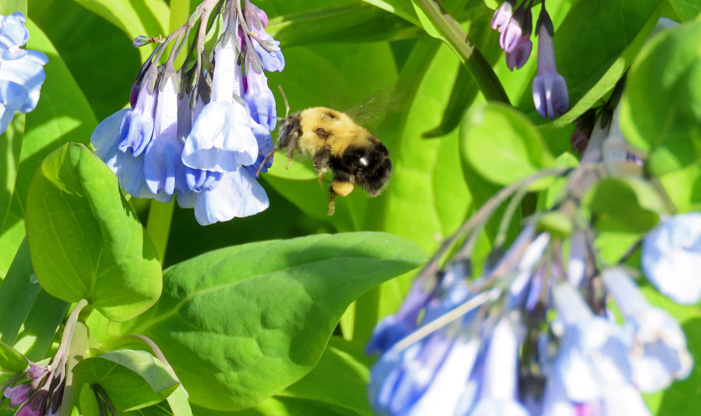As springtime blooms emerge, so do many pollinators. Some of the most interesting and important pollinators are the bees. There are around 500 species of native bees in Wisconsin. They come in a diverse array of colors, sizes, and lifestyles, and thrive, often unnoticed, right in our own neighborhoods.
Bees excel at pollination thanks to soft bristles made of chitin on their bodies, which are specially designed for pollen collection. Stiff bristles on their legs enable them to groom the pollen into specialized “baskets,” and then carry it back to their nests. Bees are the heart of a healthy ecosystem. Without pollen transfer, most plants couldn’t produce seeds. Eighty-five percent of flowering plants require animals, usually bees, to move pollen.
While we notice adult bees zipping from flower to flower, bees actually spend the majority of their lives in their nests in other life stages. Seventy percent of Wisconsin native bees nest underground, and the remaining 30% nest in stems or wood.
Spring Bees to Look for in Your Own Backyard
Bumble Bees
Due to their larger size and fuzzy bodies, bumble bee (Bombus) queens are some of the first bees to emerge from their hibernation cavities. Because bumble bees are social insects, the already mated queen emerges in late April through May ready to build her colony. She scours the landscape looking for an abandoned mouse nest or another suitable cavity. Next, she lays her eggs on a waxy pot filled with “bee bread,” formed from a mix of pollen and nectar. Her colony grows quickly as more flowers bloom, and successive broods complete metamorphosis. Once the colony builds in size, the community works together to raise the young, defend the nest, and forage for food.
Mining Bees
In early spring, you might notice a frenetic buzzing over bare patches in your garden. Look a little closer and you will likely see mining bees (Andrena). Mining bees are solitary insects that sometimes nest in large aggregations. Often newly emerged females will fly in a figure-eight above their nest entrances to orient themselves to their particular tunnel door. Males, too, will zip back and forth in mating displays. When dozens of these Andrena are buzzing about at once, it is a bee-u-tiful sight to behold. Once mated, female mining bees stock each cell with pollen and nectar, and deposit an egg on top. The bees mature in their underground apartments and repeat the cycle the following year.
Partnering With Pollinators
We humans can thank pollinators for one in every three bites of food. Why wouldn’t we want these amazing creatures to thrive? Consider taking part in these activities to help bees:
Provide shelter by keeping leaves and sticks on the ground until it warms up in spring
Plant native flowers that bloom from spring through fall
Avoid applying pesticides to your lawn
Learn more by joining a citizen science project and check out the Xerxes Society’s pollinator resource center for more information
This spring, take some time to watch the bees busy in your backyard and neighborhood. They are not only captivating to see; they contribute to the health of plant life and make the ecosystem a healthy and enjoyable place for both humans and local wildlife alike.


